Introduction: The Flying Tank Reborn
In the pantheon of military aviation, few aircraft so perfectly embody their nation’s warfighting philosophy as the Sukhoi Su-25. Known to NATO by the reporting name “Frogfoot” and to its pilots by the affectionate moniker Grach (Rook), the Su-25 is the Soviet Union‘s definitive jet-powered armored assault aircraft, a modern incarnation of the legendary World War II Shturmovik.
It is not merely a machine of war but a physical manifestation of a specific and enduring strand of Soviet and later Russian military thought, one that prioritizes direct, brutally effective, and, above all, survivable air support for ground forces.
The Su-25’s story begins with the doctrinal echoes of the Eastern Front, tracing its conceptual lineage to the iconic Ilyushin Il-2, an aircraft Josef Stalin famously characterized as being as essential to the Red Army as “air and bread”.
This heritage shaped the Su-25 into a rugged, heavily armored “flying tank,” designed not to evade threats but to withstand them.
Its decades-long combat career, stretching from the mountains of Afghanistan to the plains of Ukraine, has been a testament to this design philosophy.
This report provides a comprehensive analysis of the Su-25’s lifecycle, examining its doctrinal origins, technical design, extensive combat history, and evolution.
It also provides a critical comparison with its Western counterpart, the Fairchild Republic A-10 Thunderbolt II, and assesses its challenged legacy in the face of modern air defenses.
Part I: Genesis of the Grach – Forging a Modern Shturmovik
The Doctrinal Imperative
The conceptual foundation of the Su-25 is deeply rooted in the Soviet experience of the Second World War. The conflict solidified the doctrine of the Shturmovik, or assault aircraft, as a cornerstone of combined-arms warfare.
The Ilyushin Il-2 Shturmovik became a symbol of Soviet air power, functioning as “flying artillery” to support the Red Army’s advances directly.
This doctrine, prioritizing the tactical needs of the ground battle, became a defining characteristic of Soviet military thought.
In the post-war era, the advent of the jet age shifted air power priorities towards supersonic interceptors and fighter-bombers.
However, experience revealed a critical flaw: fast jets like the Su-7 and MiG-23 were fundamentally unsuited for the close air support (CAS) mission.
Their high speeds made visual target acquisition difficult, and they lacked the armor to survive in a battlefield increasingly saturated with anti-aircraft artillery (AAA) and man-portable air-defense systems (MANPADS).
This gap between the Soviet Army’s need for intimate air support and the VVS’s actual capability prompted the Ministry of Defence in 1968 to issue a requirement for a specialized, heavily armored, subsonic assault aircraft—a conscious decision to revive the Shturmovik concept for the modern era.
The 1969 Competition
The formal competition for the new battlefield support aircraft, announced in March 1969, attracted proposals from the Soviet Union’s premier design bureaus.
The contest ultimately became a competition between two different design philosophies, represented by Ilyushin’s Il-102 and Sukhoi’s T-8 prototype.
The Ilyushin Il-102 was a conservative, two-seat design that was a direct, jet-powered descendant of the Il-2.22 Its most anachronistic feature was a remotely-controlled, rear-facing 23 mm gun turret operated by a second crew member, a direct homage to the defensive gunner of its WWII ancestor.
In contrast, the Sukhoi T-8 was a completely new, single-seat design representing a more modern interpretation of the CAS mission.
Su-25 Frogfoot in operations in Syria. Image Credit: Creative Commons.
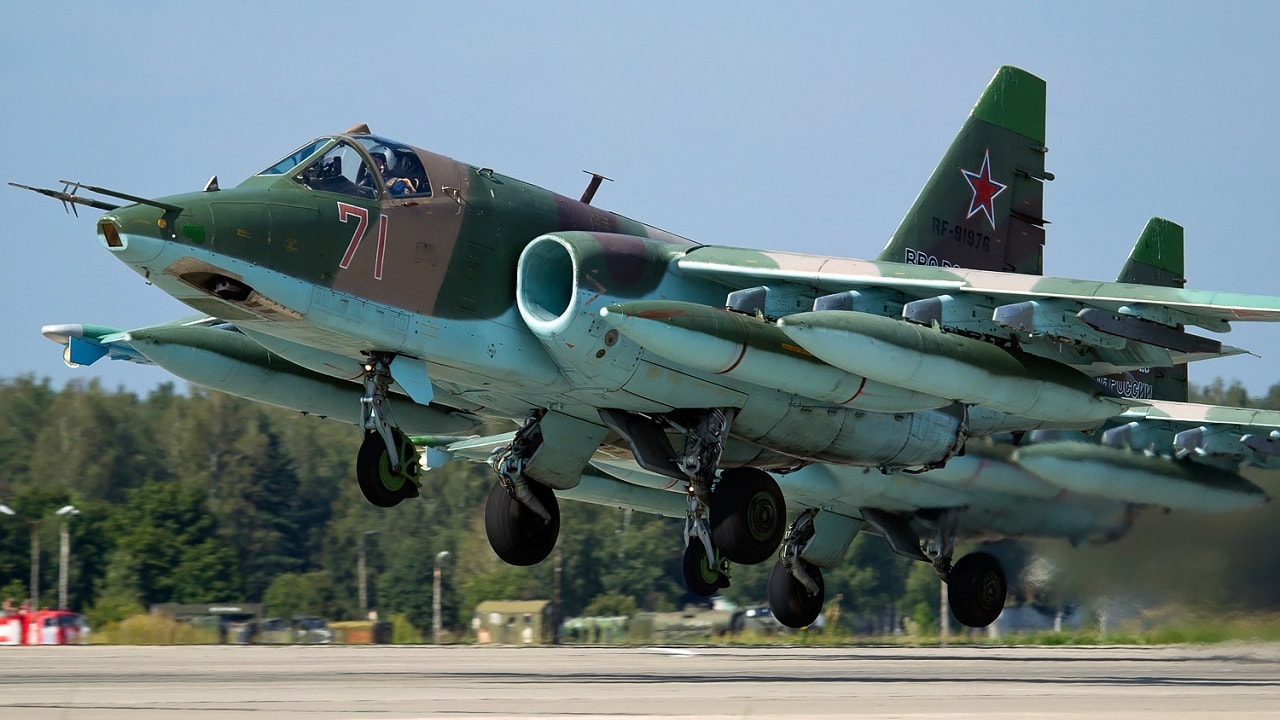
Su-25 Frogfoot. Image Credit: Creative Commons.
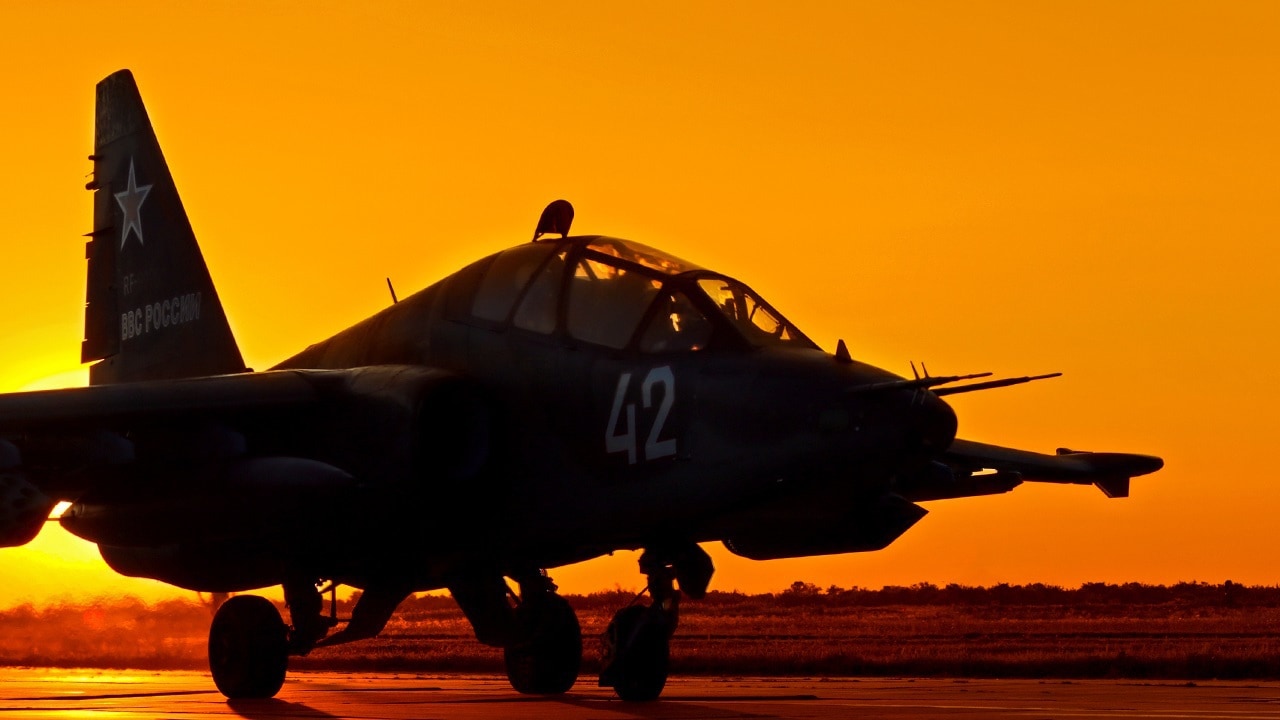
Su-25 fighter used in Russian actions in Syria. Image Credit: Creative Commons.
Sukhoi’s philosophy abandoned the defensive gunner, instead achieving survivability through a compact and agile airframe, a pilot cocooned in a titanium “bathtub,” separated twin engines, and extensive redundancy in its control systems.
The first T-8 prototype made its maiden flight on February 22, 1975, and was ultimately selected for production as the Su-25.
This choice marked a significant doctrinal turning point, rejecting the obsolete concept of a self-defending bomber in favor of a modern, systems-based approach to survivability that confronted the actual threats of the contemporary battlefield, namely ground-based air defenses.
Part II: Anatomy of a Flying Tank
The Sukhoi Su-25 is a physical manifestation of its design brief: to be a durable, survivable, and practical battlefield support aircraft. Its engineering reflects deliberate trade-offs that prioritize ruggedness and firepower over speed and technological sophistication.
The single-seat aircraft measures 15.53 meters in length with a wingspan of 14.36 meters, and has a maximum takeoff weight of 19,300 kg.
Built to Endure
The Su-25’s design philosophy is one of damage tolerance, not damage avoidance. At its heart is the cockpit, an all-welded armored enclosure often referred to as the “titanium bathtub”.
This protective shell, with thicknesses from 10 mm to 24 mm, is designed to withstand direct hits from AAA and cannon rounds.
The two Tumansky turbojet engines are housed in separate stainless-steel compartments, shielded from each other by a 5 mm-thick armored firewall to prevent a single hit from disabling both.
Vital systems and fuel tanks are similarly protected, with the tanks filled with polyurethane foam to suppress explosions.
Critically, the flight controls are connected via heavy-duty push-rods, providing a manual reversion capability that allows the pilot to maintain control even with a total loss of hydraulic power.
Propulsion and Performance
The Su-25 is powered by a pair of R-95Sh or improved R-195 non-afterburning turbojets, renowned for their simplicity and ability to run on various fuels, including diesel.
The choice of a non-afterburning engine was a crucial trade-off. While it capped the Frogfoot’s top speed below Mach 1, it significantly reduced its infrared (IR) signature, a key vulnerability to its most probable threat: heat-seeking MANPADS.
The aircraft’s straight, high-aspect-ratio wing provides excellent stability and maneuverability at the low speeds required for CAS missions.
With a maximum speed of 975 km/h, a service ceiling of 7,000 meters, and a combat range of 750 km, its performance is tailored for low-level battlefield support.17 Its robust landing gear allows operations from short, unpaved runways.
Sights and Armament
The original Su-25 featured a basic avionics package centered on an ASP-17 gunsight and a Klen-PS laser rangefinder, limiting it to daytime, clear-weather operations.
The specialized Su-25T variant, designed in the 1980s as a dedicated tank-hunter, introduced the sophisticated I-251 Shkval optical TV system, providing a true day/night precision attack capability with weapons like the Vikhr anti-tank missile.
Due to cost, the Su-25T was never mass-produced.
Instead, Russia pursued incremental upgrades for the existing fleet. The latest Su-25SM3 “Super Grach” features a modern navigation and attack suite, the Vitebsk-25 electronic countermeasures system, and the SOLT-25 electro-optical targeting system, allowing it to employ a range of modern precision-guided munitions.
The Frogfoot’s main gun is an internal 30mm GSh-30-2 twin-barrel cannon with 250 rounds.21 Its primary strength, however, lies in its ability to carry up to 4,400 kg of ordnance on ten hardpoints.
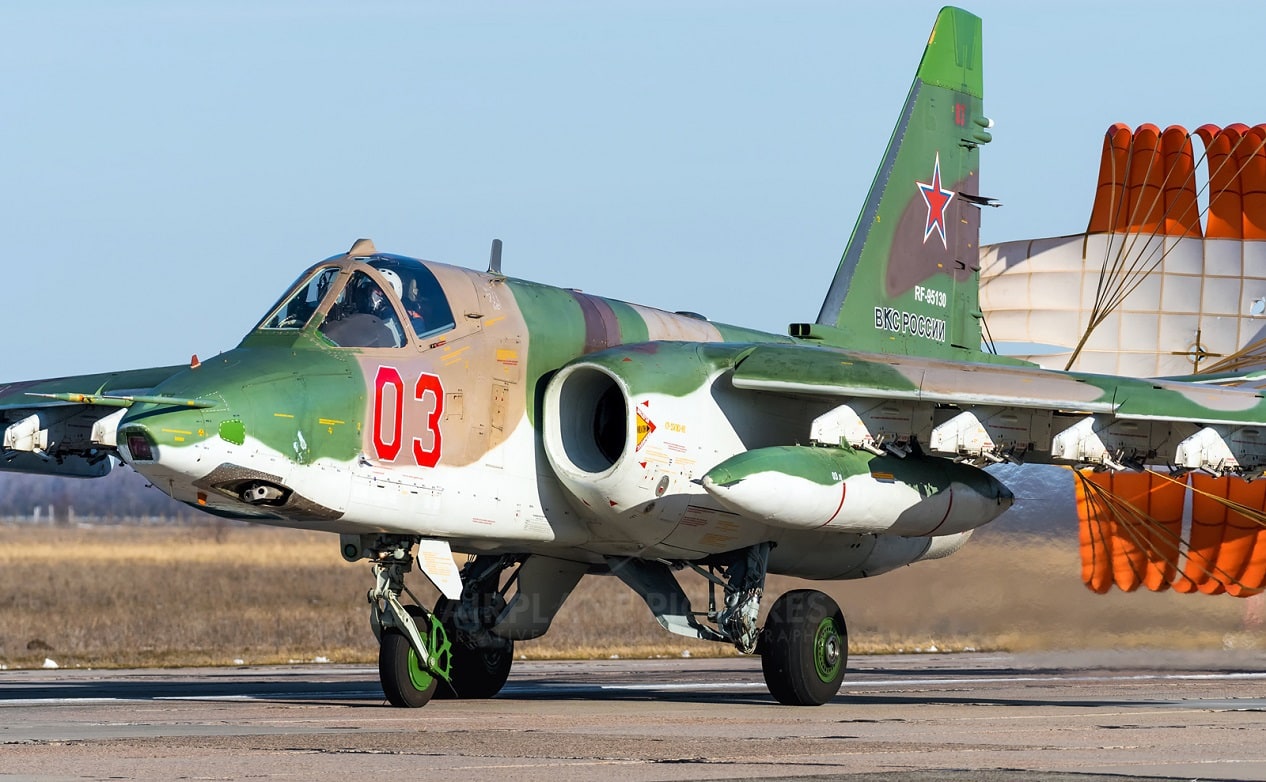
Su-25. Image Credit: Creative Commons.
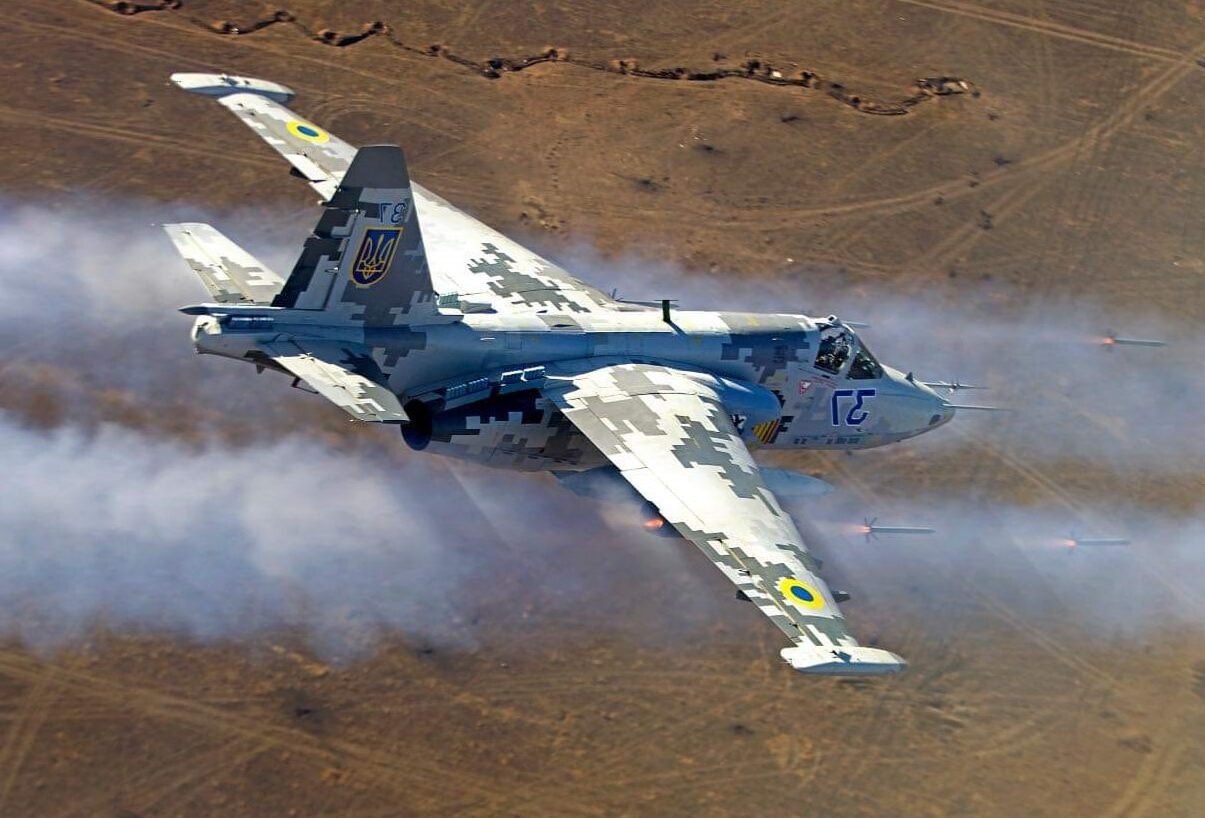
Su-25. Image Credit: Creative Commons.

Image: Creative Commons.
This typically consists of unguided FAB-series bombs and a wide variety of rocket pods (S-5, S-8, S-13) and heavy rockets (S-24, S-25), fulfilling its role as “flying artillery”.
Guided weapons include the Kh-25ML and the heavier Kh-29L laser-guided missiles.45 For self-defense, it carries R-60 or the more capable R-73 short-range air-to-air missiles.
Part III: A Legacy Forged in Fire
The Su-25’s design philosophy of extreme ruggedness and battlefield utility has been tested in a remarkable number of conflicts over more than four decades. Its operational history is a story of both brutal effectiveness and stark vulnerability, providing a clear barometer of the evolving nature of ground-based air defenses.
Trial by Fire in Afghanistan and Beyond
The Su-25’s baptism by fire in Afghanistan cemented its legendary toughness. It flew over 60,000 sorties, proving ideal for counter-insurgency strikes in the mountainous terrain.
However, the introduction of US-supplied FIM-92 Stinger MANPADS changed the battlefield. The Frogfoot, designed to withstand cannon fire, proved highly vulnerable to these heat-seeking missiles, and approximately 23 aircraft were lost in combat.
This “Stinger shock” forced a rapid evolution in tactics, with pilots shifting to higher-altitude attacks and employing the first Soviet precision-guided munitions like the Kh-25 and Kh-29 from safer standoff ranges.
In the post-Soviet era, the Su-25 became a staple of regional conflicts. Iraq used it effectively in the final stages of the Iran-Iraq War, flying 900 sorties with only two losses.
Russia relied on it heavily in Chechnya, where it operated in a permissive air environment.
The 2008 Russo-Georgian War, where both sides operated the type, highlighted its vulnerability to more capable SAM systems like the Buk-M1, with Russia losing three Su-25s.
The Su-25 also saw service with numerous African air forces, including Angola and Ethiopia, and was used decisively by North Macedonia during its 2001 insurgency.
A Russian Su-25 was lost to a MANPADS in Syria in 2018, a potent reminder of the persistent threat.
The Grinding War in Ukraine
The 2022 full-scale invasion of Ukraine has become the ultimate and most brutal test for the Su-25. Both Russia and Ukraine have operated the type extensively, suffering catastrophic attrition.
The battlefield is saturated with a dense array of modern air defenses, from thousands of MANPADS to advanced SAMs.
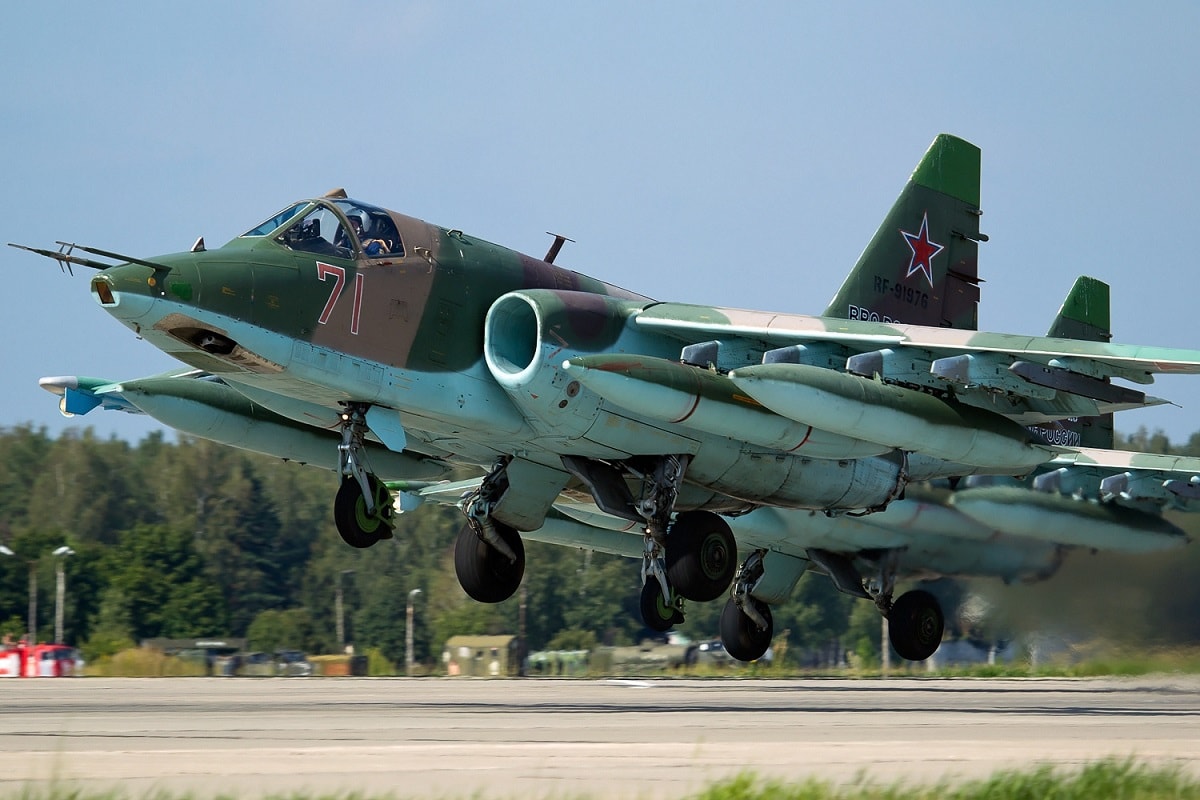

In this environment, the Su-25’s traditional low-level CAS role has become suicidal.
Pilots on both sides have been forced to adopt “loft-bombing” tactics, releasing unguided rockets in a high arc from a safe distance, sacrificing all accuracy for a marginal chance of survival.
The war has demonstrated that the Su-25 is a victim of its own proliferation, flying into the teeth of the very Soviet-era air defense systems designed to counter its Western counterparts.
Part IV: Comparative Analysis and Evolution
Frogfoot vs. Warthog
The Su-25 and the A-10 represent distinctly different answers to the same fundamental question, shaped by the divergent military doctrines of the Soviet Union and the United States.
- Armament and Role: The most defining difference lies in their main armament. The A-10 is famously an “aircraft built around a gun,” its GAU-8 Avenger a specialized anti-tank weapon with over 1,100 rounds. The Su-25’s GSh-30-2 cannon, with only 250 rounds, is a secondary weapon. The Frogfoot’s primary role is that of a “bomb and rocket truck,” designed to deliver a large volume of unguided ordnance for area suppression, fulfilling the Soviet doctrine of “flying artillery.”
- Survivability: Both are tough, but their approaches differ. The A-10 emphasizes redundancy, with widely spaced, high-mounted engines and triple-redundant flight controls. The Su-25 relies on a more compact design and the extreme protection of the pilot within its titanium “bathtub.”
- Performance: The Su-25 is considerably faster than the A-10, reflecting a doctrine of fast-in, fast-out strikes. The A-10 was designed to loiter over the battlefield for extended periods, a mission enabled by its greater fuel efficiency.
These choices reflect their parent doctrines. The A-10 is a weapon of a dominant air force; the Su-25 is a weapon of a dominant ground army.
The Frogfoot Family
The Su-25’s long service life has resulted in an extensive family of variants. Key versions include the baseline Su-25, the export Su-25K, and the two-seat Su-25UB trainer.
An ambitious leap was the Su-25T, a dedicated all-weather anti-tank platform with the Shkval targeting system.17 Due to cost, it was never mass-produced.
Instead, Russia pursued the more pragmatic Su-25SM/SM3 modernization program, which incrementally improves the existing fleet with new digital avionics, a HUD, and enhanced self-defense systems, allowing the use of modern guided weapons.
The Twilight of the Shturmovik?
The Evolving Mission
The war in Ukraine has dramatically accelerated the evolution of the CAS mission, likely rendering the Su-25’s entire operational concept obsolete. The extreme lethality of the modern air defense environment has made the Frogfoot’s core tactic—flying low and slow near the front lines—a mission with an unacceptably high attrition rate.
A new model of air support has emerged, driven by two key technologies: standoff glide bombs and tactical drones. This has led to a “disaggregation” of the traditional CAS role.
The function of delivering heavy ordnance is now primarily performed by multirole fighters like the Su-34, launching UMPK glide bombs from distances of 50-70 km, far outside the range of most frontline air defenses.
Meanwhile, the role of providing “eyes on target” and conducting precision strikes in close proximity to friendly troops has been almost entirely taken over by a vast ecosystem of low-cost FPV and tactical drones.
This new paradigm splits the Su-25’s mission into two functions performed by more survivable and cost-effective platforms.
Conclusion
The Sukhoi Su-25 Grach is one of the most significant combat aircraft of the late 20th century.
Born from a clear doctrinal need to revive the spirit of the WWII Shturmovik, it became a pure expression of Soviet design philosophy: a simple, rugged, and cost-effective tool built to absorb punishment and deliver devastating firepower in direct support of ground forces.
Its combat record is extensive and varied, proving its effectiveness in permissive environments and its stark vulnerability in the face of modern, layered air defenses.
However, the very conflicts that built its reputation have also signaled its obsolescence. The introduction of effective MANPADS in Afghanistan began a cycle of threat and response that has culminated in the skies over Ukraine.
There, the Su-25 has been forced into tactics that negate its accuracy, and it has suffered unsustainable losses. The modern battlefield, dominated by standoff weapons and attritable drones, has disaggregated the close air support mission into constituent parts that are now performed more safely and efficiently by other platforms.
The Rook’s reign over the front lines is ending. While the airframe will likely continue to serve in the air forces of smaller nations and in low-intensity conflicts for years to come, its role as a frontline assault aircraft in a peer-level conventional war is over.
It is being rendered obsolete not because a better warlane has replaced it, but because the nature of the game has fundamentally changed, leaving the venerable flying tank as a powerful but ultimately outmoded relic of a bygone era of warfare.
About the Author: Harry J. Kazianis
Harry J. Kazianis (@Grecianformula) is a national security expert based in Orlando, Florida. Kazianis was Senior Director of National Security Affairs at the Center for the National Interest (CFTNI), a foreign policy think tank founded by Richard Nixon based in Washington, DC. He also served as Executive Editor of its publishing arm, The National Interest. Harry has over a decade of experience in think tanks and national security publishing. His ideas have been published in the NY Times, Washington Post, Wall Street Journal, CNN, and many other outlets worldwide. He has held positions at CSIS, the Heritage Foundation, the University of Nottingham, and several other institutions related to national security research and studies.



